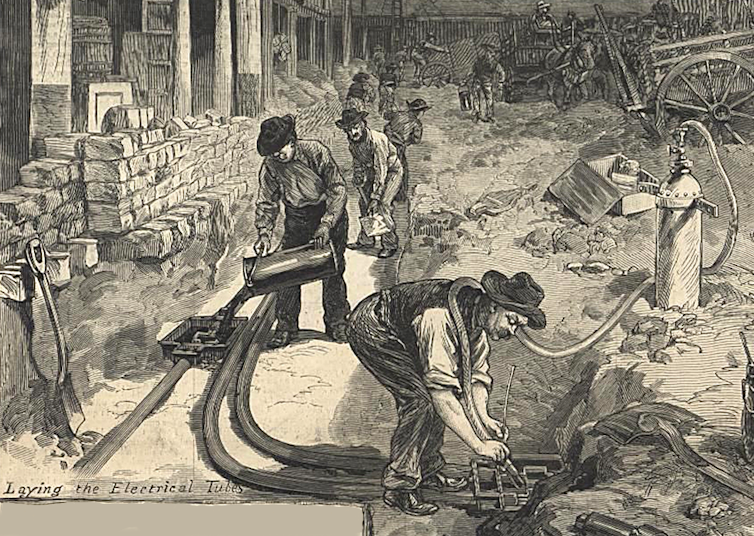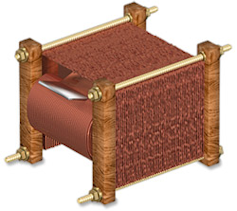'The Current War: Director's Cut' shows how the electric power system we take for granted came to be
- Written by Jay Apt, Professor, Tepper School of Business, Engineering and Public Policy and Co-Director, Carnegie Mellon Electricity Industry Center, Carnegie Mellon University
Many experts view the electric power grid as the greatest engineering achievement[1] of the 20th century. But if Thomas Edison[2], inventor of the first commercial power plant[3], had had his way, the modern grid would not have been built. Instead the U.S. would have been powered by numerous coal-burning power plants, spaced a mile or so apart, with no electricity at all in rural areas.
Another electricity pioneer, engineer and inventor George Westinghouse[4], was convinced that Edison’s system wouldn’t scale, to use a modern term. When Westinghouse heard of a technology that would allow electricity to be sent over long distances with only small losses, he jumped into the electric power business.
“The Current War: Director’s Cut[5]” tells the story of their competition. While the movie isn’t completely faithful to history, it shows how dramatically technological breakthroughs that may seem esoteric at the time can affect everyday life.
The U.S. power grid has more than 160,000 miles of transmission lines that move electricity from power plants to cities and towns. Alternating current made it feasible.A key choice
“The Current War” turns on the choice between alternating or direct current[6] to move electric power from generating stations to customers.
Direct current, or DC, flows steadily, like water pouring from a pitcher into a glass. Modern flashlights run on DC batteries, which provide steady power – at least, until they run down. Alternating current, or AC, periodically reverses direction, ebbing and flowing much like the rush of water from a vintage hand pump as the handle is pushed up and down.
Both DC and AC can be used for running light bulbs and equipment, but when either type of current moves over electrical cables, it loses some power to the resistance of the wires. Increasing the voltage, or pressure that makes the electric current flow, greatly reduces the losses. For example, if voltage is doubled, power loss decreases by a factor of four.
 Image from Harpers Weekly of workmen burying DC power lines from Edison’s Pearl Street generating station in New York City, 1882.
Wikimedia[7]
Image from Harpers Weekly of workmen burying DC power lines from Edison’s Pearl Street generating station in New York City, 1882.
Wikimedia[7]
When Edison’s DC system reached the market in 1882, increasing its voltage to reduce transmission losses was far beyond the technology of the day. On the other hand, increasing or decreasing AC voltage – the version that Westinghouse was developing – required only an inexpensive piece of iron wound with a few coils of wire.
Westinghouse saw the revolutionary potential of this apparatus, which would soon be known as a voltage transformer[8], when he read a technical account of a system displayed at the 1885 London Inventions Exhibition[9]. A much better business executive than Edison[10], Westinghouse realized that power could be efficiently transmitted over many miles at high voltage, greatly reducing the need to build power generating plants.
He obtained the American patent rights to the transformer and immediately formed Westinghouse Electric. It took another seven years, and the genius of Serbian immigrant Nikola Tesla[11]– who invented a series of durable, adaptable motors that ran on AC[12], then sold the patents to Westinghouse – before people recognized that AC power provided energy much more cheaply than DC power.
Inventing stories
 The first commercial transformer, designed by William Stanley for Westinghouse in 1886, made it easy to increase and decrease the voltage of a flow of alternating current.
National High Magnetic Field Laboratory, CC BY-ND[13][14]
The first commercial transformer, designed by William Stanley for Westinghouse in 1886, made it easy to increase and decrease the voltage of a flow of alternating current.
National High Magnetic Field Laboratory, CC BY-ND[13][14]
Like Steve Jobs[15] at Apple, Edison created myths[16] as he was creating the future. “The Current War” repeats a whopper that Edison spun about sending scores of employees to search Earth for just the right filament to make his light bulbs burn for more than 10 minutes.
In the late 1870s, Edison and English chemist Joseph Swan produced light bulbs that used cotton filaments coated with carbon as their light-emitting elements. Edison’s key advance was in perfecting equipment to suck air out of the bulb and seal it[17], which prevented the filament from burning up by removing oxygen from the bulb’s interior. The filament in the evacuated bulb lasted over 13 hours, but Edison’s exaggerated story of pith-helmeted explorers searching for materials lasted over a century.
“The Current War” commits two more serious errors. First, it shows Franklin Pope[18], Westinghouse’s chief engineer, electrocuting himself while laboring to perfect an AC generator in Pittsburgh. In fact, Pope worked for Edison in the late 1860s on projects that included inventing the stock ticker[19], and then became a patent attorney with Westinghouse as a client. He died troubleshooting high-voltage equipment in his Massachusetts basement[20] in 1895, years after the events central to the movie.
Second, the film’s conclusion is set at the opening of the 1893 Chicago World’s Fair[21], which was lit by Westinghouse’s alternating current[22]. The scene cuts back and forth to the execution of a convicted murderer in New York, in an AC-powered electric chair. Edison had touted the electric chair to New York state officials, hoping to discredit AC power by making it synonymous in the public’s mind with death by electrocution. But although the execution was botched[23] and it took four minutes for the condemned man to die, Edison’s gambit failed. And it took place in 1890, three years before the fair.
Modern DC versus AC
Today, advances in power electronics have made it practical and economical to transform the voltage of DC with devices much smaller than those used for AC, enabling wider use of direct current. DC offers some important benefits: It is what our digital equipment and new LED lamps use, so it avoids conversion losses from AC to DC.
Electric vehicle batteries run on direct current.High-voltage DC transmission lines[24] now bring power from Canada’s hydropower dams to Boston. Solar panels produce direct current, and visionaries are imagining buildings wired entirely for DC[25], feeding LED lighting and charging DC batteries in electric vehicles. Direct current microgrids[26] that generate and store electricity locally can increase resilience to natural disasters or deliberate attacks.
The U.S. power system ultimately could marry Edison’s and Westinghouse’s visions. But since AC technology is pervasive, this transition could take decades.
For a more accurate account of the Current War, I recommend historian Jill Jonnes’ wonderful book, Empires of Light: Edison, Tesla, Westinghouse, and Their Race to Electrify the World[27]. But “The Current War: Director’s Cut” gets two key points right. First, creating technology has been a driver of national greatness for much of America’s history. Second, inventions that can make it in the marketplace are the ones that really can change the world.
[ You’re smart and curious about the world. So are The Conversation’s authors and editors. You can get our highlights each weekend.[28]. ]
References
- ^ greatest engineering achievement (www.greatachievements.org)
- ^ Thomas Edison (www.nps.gov)
- ^ first commercial power plant (ethw.org)
- ^ George Westinghouse (www.britannica.com)
- ^ The Current War: Director’s Cut (www.currentwarmovie.com)
- ^ alternating or direct current (science.howstuffworks.com)
- ^ Wikimedia (en.wikipedia.org)
- ^ voltage transformer (www.electronics-tutorials.ws)
- ^ 1885 London Inventions Exhibition (en.wikipedia.org)
- ^ better business executive than Edison (www.penguinrandomhouse.com)
- ^ Nikola Tesla (theconversation.com)
- ^ durable, adaptable motors that ran on AC (www.pbs.org)
- ^ National High Magnetic Field Laboratory (nationalmaglab.org)
- ^ CC BY-ND (creativecommons.org)
- ^ Steve Jobs (www.fastcompany.com)
- ^ created myths (theconversation.com)
- ^ suck air out of the bulb and seal it (ethw.org)
- ^ Franklin Pope (ethw.org)
- ^ inventing the stock ticker (www.telegraph-history.org)
- ^ in his Massachusetts basement (www.berkshireeagle.com)
- ^ 1893 Chicago World’s Fair (www.encyclopedia.chicagohistory.org)
- ^ Westinghouse’s alternating current (www.youtube.com)
- ^ the execution was botched (www.washingtonpost.com)
- ^ High-voltage DC transmission lines (www.powermag.com)
- ^ wired entirely for DC (www.nema.org)
- ^ Direct current microgrids (www.navigantresearch.com)
- ^ Empires of Light: Edison, Tesla, Westinghouse, and Their Race to Electrify the World (www.penguinrandomhouse.com)
- ^ You can get our highlights each weekend. (theconversation.com)
Authors: Jay Apt, Professor, Tepper School of Business, Engineering and Public Policy and Co-Director, Carnegie Mellon Electricity Industry Center, Carnegie Mellon University


